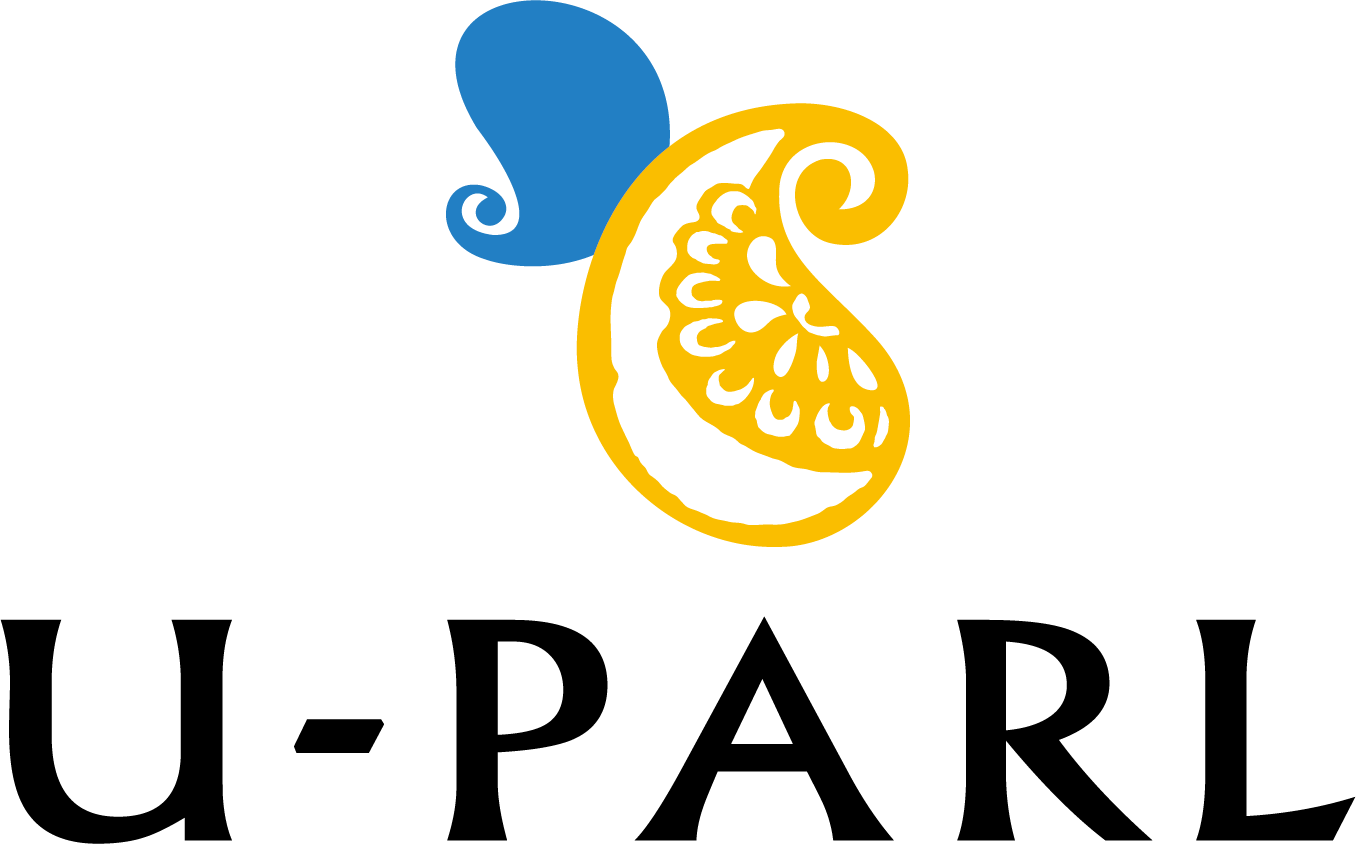SHIBUYA Yuki (U-PARL Collaborative Researcher)
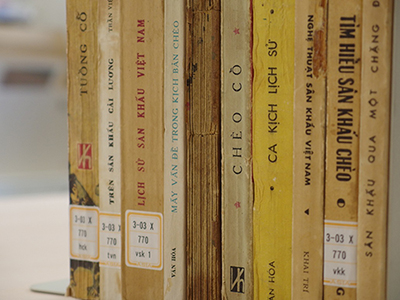
The SAKURAI Yumio Collection at the Asian Research Library of the University of Tokyo is a collection named after and based on the personal materials of the late scholar of history and area studies, SAKURAI Yumio. The details of the collection are outlined in another article on this website under the title “SAKURAI Yumio Collection.” The main takeaway is that the collection primarily consists of books on Vietnamese history written in the local language but there are also many works going beyond the subject of history, including geography, politics, economics, and agriculture, reflecting the wide variety of SAKURAI’s academic interests and research methods.
The most interesting fact about the collection is that some materials seem to be unrelated to SAKURAI’s research. Those who knew SAKURAI during his lifetime would be surprised to find such literature in the collection. Among them are books on traditional Vietamese theater.
There are four main types of performance in Vietnamese theater. Please note that various theories exist with regard to the origins of each type, besides the ones presented here.
(1) chèo, a purely Vietnamese folk song-and-dance drama that originated in the 10th century and spread in its present form in the 18th century. It has been performed in the precincts of shrines where local guardian deities are worshiped, mainly in the villages of the northern Red River Delta.
(2) tuồng, a classical song-and-dance drama said to have one of its origins in Chinese theater introduced to Vietnam during the Mongol Invasion in the late 13th century. It developed mainly in the central part of Vietnam during the period of civil strife and internal wars in the 16th to 18th centuries, and was loved by the Nguyen royal court, the last royal dynasty in Vietnam.
(3) cải lương (translated roughly as “reformed theater”), a song-and-dance drama created in the South during the French colonial period after World War I as a new art form based on folk songs from the Mekong Delta. It was an “improvement” upon Tuong and became very popular in the South of the country in the 1960s.
(4) múa rối nước, a unique Vietnamese water puppet show said to have been performed in the northern Red River Delta in the 12th century.
The SAKURAI Yumio Collection includes overviews, books, scripts, and encyclopedias on Vietnamese theater in general, as well as by each genre. To put this in figures, as of September 2021, there were approximately 75 bibliography entries that would come up if you searched by the subject heading ‘Theater – Vietnam’ in CiNii Books (a service that allows users to search for information on books held by university libraries and other institutions nationwide across Japan). All in all, there are not many books on Vietnamese theater in Japanese libraries. Only a few are registered at the University of Tokyo Library, and even fewer at neighboring universities such as the Tokyo University of Foreign Studies Library. The collection of books on traditional Vietnamese theater formerly owned by the late SAKURAI Yumio should somewhat compensate for the paucity of literature on the subject at the University of Tokyo and in the Kanto region in general.
For many readers, literature on traditional theater may be a difficult genre to approach. It also does not help that in Japanese academic circles, Vietnamese traditional theater (with the sole exception of water puppetry) has received less attention than the traditional theater of other Southeast Asian countries, such as Indonesia.
However, in MAEKAWA Kenichi ‘s Tai betonamu shiyo massetsu ryoko [Miscellaneous Travels in Thailand and Vietnam] (1996, Mekong Publishing), the author notes that he was “quite satisfied” with the Cai Luong that he saw in Ho Chi Minh City (p. 220). Photojournalist KIMURA Satoru, in his book Mekonderuta no tabigeinin [Traveling Performers in the Mekong Delta] (2019, Commons), recalls the open-air Cai Luong performance by a troupe of travelling entertainers, “I felt a rush of adrenaline and dopamine. Having lost all sense of time, I spent a tremendous amount of film taking picture after picture. I felt that sweat poured off my body, and I was running out of breath. By the time I came to my senses, the play was already over” (p. 9). This passage, alongside other examples from popular literature, clearly demonstrate that Vietnamese traditional theater can appeal to all the visitors to the country by breaking the language barrier. In 2020, the film Song Lang (The Tap Box) (2018, directed by Leon Le), featuring a character who performs Cai Luong, was released in Japan. Interest in traditional Vietnamese theater, and especially Cai Luong, appears to be growing like never before among Asian film fans.
A closer look at the origins of Tuong and Cai Luong also reveals the fact that traditional Vietnamese theater has been influenced by theater from other parts of Asia and even Europe. In other words, Vietnamese theater studies is not about just Vietnam.
The following are examples of books from the SAKURAI Yumio Collection on traditional Vietnamese theater and Vietnamese folk instruments—these two always go hand-in-hand. Some of the books are quite easy to understand for those unfamiliar with the subject or with little to no knowledge of Vietnamese: there are illustrations and musical scores. Anyone interested in traditional Vietnamese theater should definitely pick up a copy from the list below.
Note: Listed in chronological order of publication by subject.
[General theatrical performances]
Trần Văn Khải. 1970. Nghệ-thuật sân-khấu Việt-Nam: Hát-bội, cải-lương, thoại-kịch, thú xem diễn kịch. [Saigon]: Khai-trí.
Tran Van Khai. (1970). Vietnamese theater arts: Hat Boi, Cai Luong, Dialogue Drama, Enjoying Watching Plays. Saigon: Khai-tri.
This is an overview of Hat Boi, Cai Luong and dialogue drama. Hat Boi is another name commonly used in the south for Tuong. The book emphasizes the fact that Hat Boi is distinctly unique to Vietnam. It also includes illustrations of makeup with commentary and multi-colored printing. A lot of space is devoted to Cai Luong.
Viện Sân khấu, ed. 1984. Lịch sử sân khấu Việt Nam (Sơ thảo). Tập 1. Hà Nội: Viện Sân khấu.
Academy of Theater (Ed.). (1984). History of Vietnamese Theater (Draft). Vol. 1, Hanoi: Academy of Theater.
A history of theater published in Hanoi before Doi Moi. Volume 2 is held at the Tokyo University of Foreign Studies Library. Volume 1 covers the development of Tuong, Cheo, and water puppet theatre from 1945 to 1975. The Cheo section contains a list of articles and books on the subject published between 1954 and June 1974.
Hội Nghệ sĩ Sân khấu Việt Nam, ed. 1984. Sân khấu qua một chặng đường lịch sử (kỷ yếu đại hội II Hội nghệ sĩ sân khấu Việt Nam). Hà Nội: Hội Nghệ sĩ Sân khấu Việt Nam.
The Vietnam Performing Artists Association (Ed.). (1984). Theater Through a Historical Journey (Bulletin of the second congress of the Vietnam Performing Artists Association). Hanoi: The Vietnam Performing Artists Association.
This is a bulletin of a research conference held in Hanoi in 1983. At the end of the book are congratulatory speeches sent to the conference by the People’s Army of Vietnam, the Ministry of Home Affairs, and provincial People’s Committees. An interesting source for understanding the social background of the time.
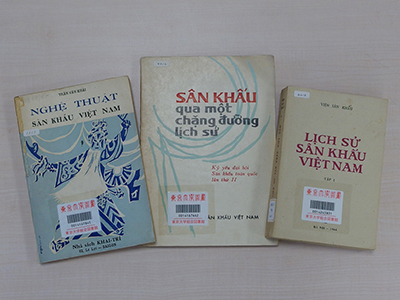
[Cheo]
Vũ Khắc Khoan. 1974. Tìm hiểu sân khấu chèo. [Saigon]: Lửa thiêng.
Vu Khac Khoan. 1974. Tìm hiểu sân khấu chèo [A consideration on Cheo Stage]. [Saigon]: Lua thieng.
An annotated study on Cheo published in the South just prior to the reunification of North and South Vietnam in 1975. The book contains extensive quotations from and references to classical texts. The only domestic copy is held by the Asian Research Library of the University of Tokyo.
Hà Văn Cầu, comp. 1976. Tuyển tập chèo cổ. Hà Nội: Văn hóa.
Ha Van Cau (comp.). (1976). Anthology of classical Cheo. Hanoi: Culture Publishing House.
This publication is the result of a project by the Democratic Republic of Vietnam to revive Cheo by inviting artists who were active in this type of performing arts before the August Revolution. The book includes “Quan Âm Thị Kính” and six other plays.
Hà Văn Cầu. 1977. Mấy vấn đề trong kịch bản chèo. Hà Nội: Văn hóa.
Ha Van Cau. (1977). Some issues related to scripts of Cheo performances. Hanoi: Culture Publishing House.
This book discusses four aspects of Cheo: dialogue, characters, mannerisms, and style. At the beginning of the book, there is a commentary on the history of Cheo up to the 1970s.
Ca kịch lịch sử. 1979. Hà Nội: Văn hóa.
Historical opera. (1979). Hanoi: Culture Publishing House.
This entry contains scripts for four historical plays, primarily for Cheo.
[Tuong]
Hoàng Châu Ký, comp. 1978. Tuồng cổ. Hà Nội: Văn hóa.
Hoang Chau Ky (comp.). (1978). Classical Tuong. Hanoi: Culture Publishing House.
This compilation includes a comprehensive overview of Tuong and the most popular plays of this genre, “Sơn Hậu” and “Tam Nữ Đồ Vương,” with an outline, character introduction pages, and a whole script for both plays.
Nguyễn Lộc and others, eds. 1998. Từ điển nghệ thuật hát bội Việt Nam. Hà Nội: Khoa học xã hội.
Ngyuen Loc, et al. (Eds.). (1998). Dictionary of Hat Boi, Vietnamese Performing Arts. Hanoi: Social Sciences Publishing House.
An encyclopedia of Tuong published in Hanoi after Doi Moi. Contains a preface in English.
[Cai Luong]
Vương Hồng Sển. 1968. Cải-lương đã 50 tuổi: Hồi-ký 50 năm mê hát. Sài Gòn: Phạm Quang Khai.Vuong Hong Sen. (1968). Cai Luong Turning 50: A Memoir of 50 Years Together with Singing. Saigon: Pham Quang Khai.
This is a collection of writings on Cai Luong by Vuong Hong Sen, a famous intellectual from the South born in 1902.
Trần Việt Ngữ. 1986. Ba Vân: Trên sân khấu cải lương. Hà Nội: Văn hóa.
Tran Viet Ngu. (1986). Ba Van: On the Stage of Cai Luong. Hanoi: Culture Publishing House.
This is a biography published shortly before the passing of Ba Van, a notable Cai Luong actor born in the South in 1908. Ba Van was active in the entertainment industry in both North and South Vietnam from the French colonial period until the 1980s.
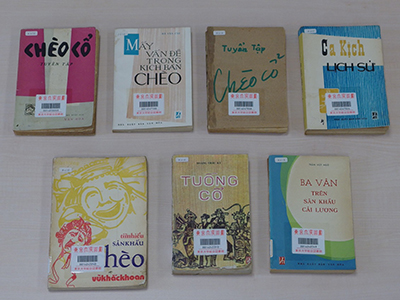
[Vietnamese Folk Instruments]
Lê Huy and Huy Trân. 1984. Nhạc khí dân tộc Việt Nam. Hà Nội: Vǎn hóa.
Le Huy and Huy Tran. (1984). Vietnamese Folk Instruments. Hanoi: Culture Publishing House.
This book introduces the structure, characteristic sound, and playing techniques of each of the approximately 26 types of Vietnamese folk instruments. The only domestic copy is held by the Asian Research Library of the University of Tokyo.
Xuân Khải and Đức Bằng. [1983]. Sách học nguyệt. [Hà Nội]: Văn hóa.
Xuan Khai and Duc Bang. (1983). Let’s Learn Đàn Nguyệt. Hanoi: Culture Publishing House.
A textbook teaching the dan ngyuet, a two-stringed Vietnamese traditional musical instrument. Even today, it is difficult to find instructional books on ethnic instruments at bookstores in Vietnam.
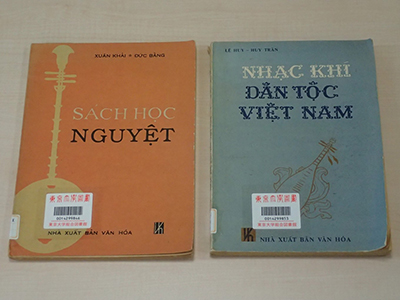
<Further references>
SHIMIZU, Masaaki and IZAWA, Ryosuke. (2014). “Betonamu no geino:minzoku no ido、gaiteki eikyo ni yoru dento geino no hirogari (Performing Arts in Vietnam: The Expansion of Traditional Performing Arts Through Ethnic Migration and Other External Factors),” in AKAMATSU, Norihiko (Ed.), Chosen hanto、indo、tonan ajia no shi to geino [Poetry and Performing Arts in Korea, India, and Southeast Asia], 134-143. Kyoto University of the Arts and Tohoku University of Art and Design Press, Department of Art Studies.
Pawit Mahasarinand, Ty Bamla, Jennifer Goodlander, Khoun Chanreaksmey, Siyuan Liu, and Trinh Nguyen. 2016. “Modern theatre in mainland Southeast Asia.” In Routledge handbook of Asian theatre, edited by Siyuan Liu, 351-369. London: Routledge.
8.Apr. 2024
